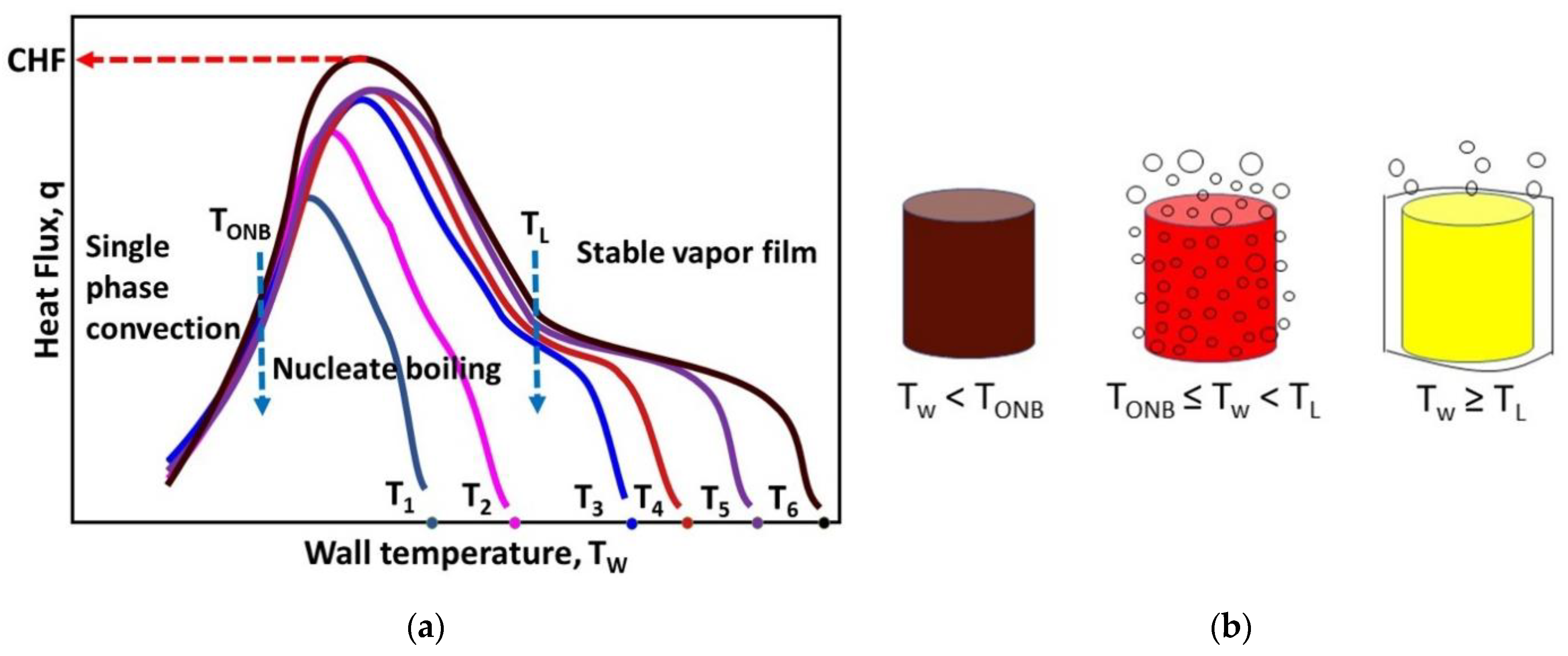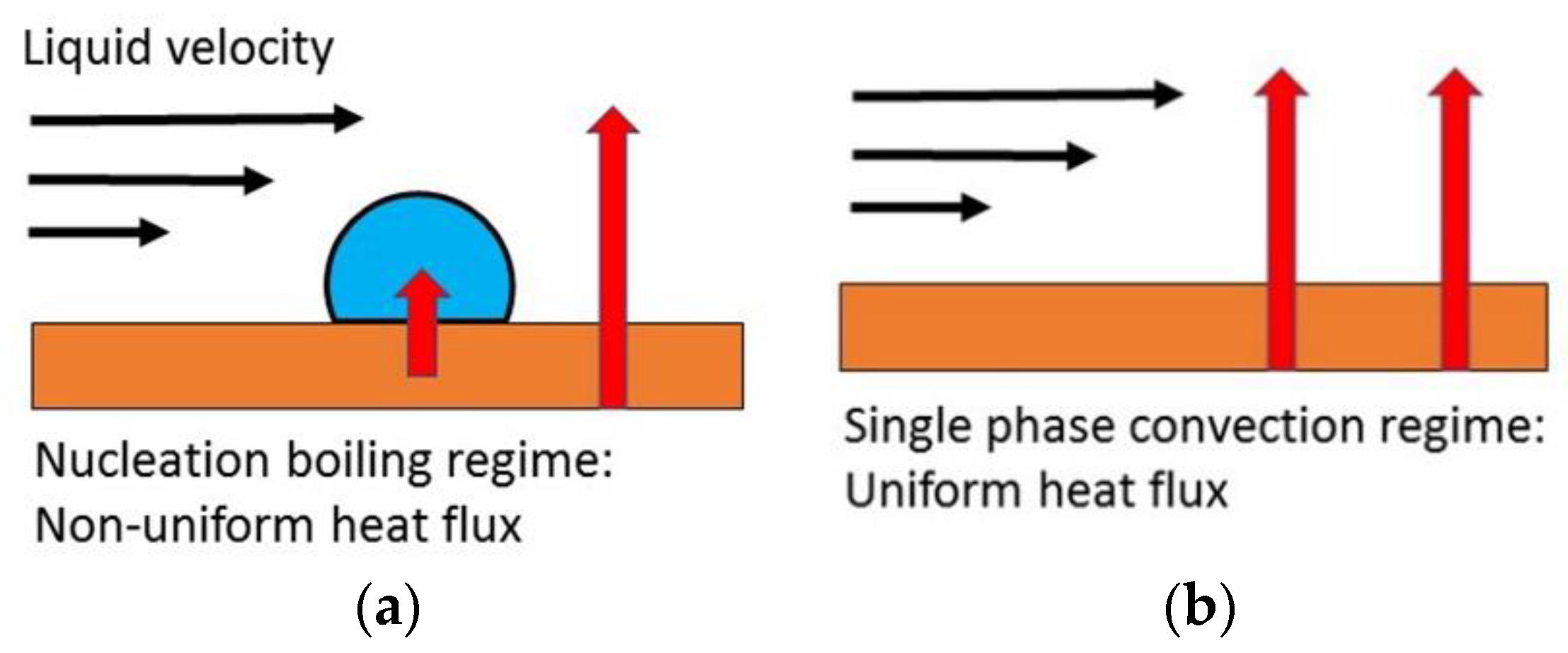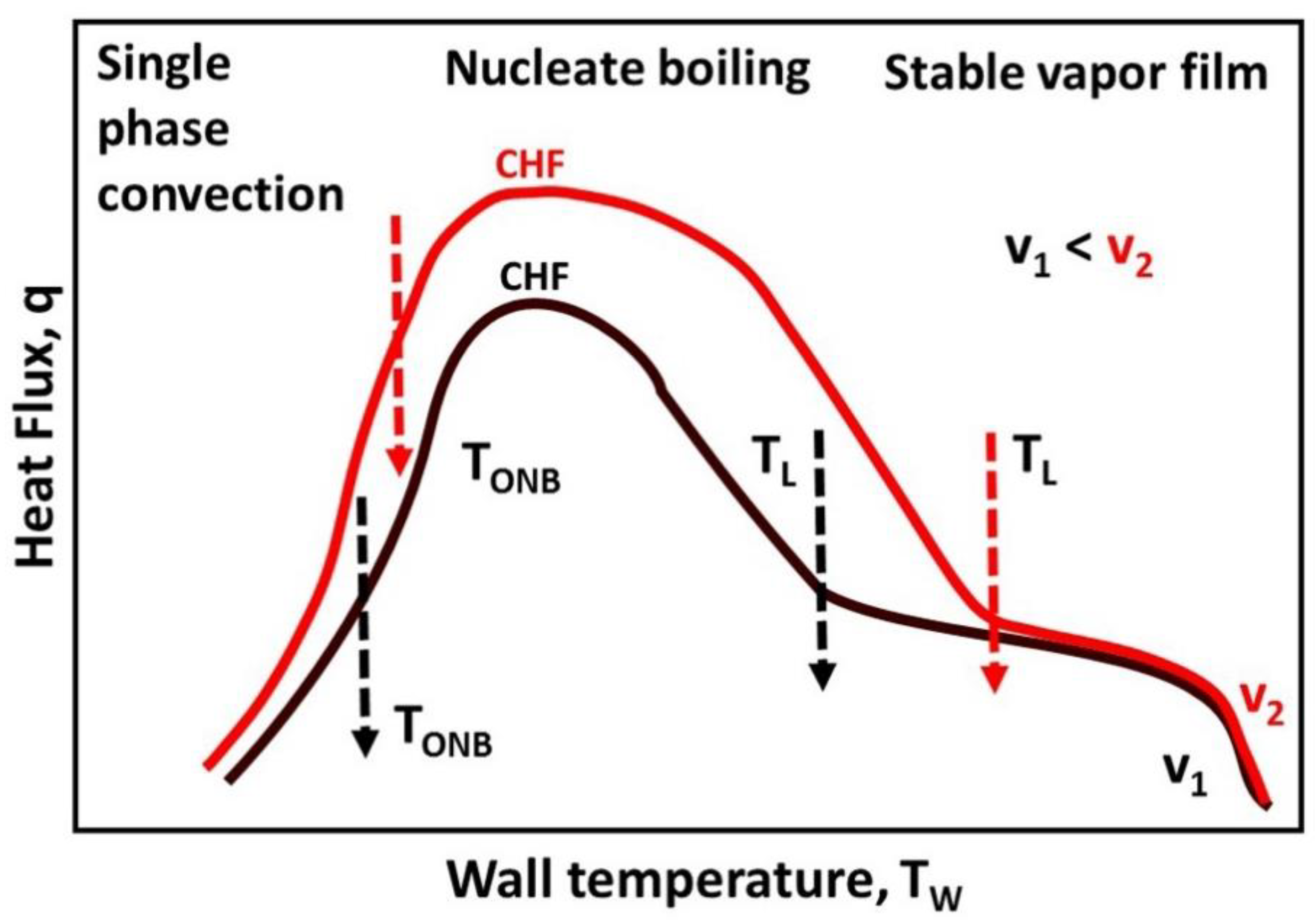A Review of the Boiling Curve with Reference to Steel Quenching
Abstract
:1. Introduction
2. Steel Heat Treating Concepts
3. Boiling and Quenching Heat Transfer
3.1. Boiling Curve Determination
3.2. Effect of Initial Temperature of the Solid Workpiece
3.3. Effect of Quenchant Liquid
3.4. Effect of Liquid Velocity and Wall Temperature
3.5. Effect of Wall Surface Roughness and Wettability
3.6. Effect of Solid Properties and Workpiece Size
3.7. Link between Heat Transfer Coefficient, H, and Quenching Severity, H
3.8. Hardenability Determination, the End-Quench Jominy Test
4. Discussion of Poorly Attended Aspects of the Boiling Curve
4.1. Initial Wall Heat Flux
4.2. Definition of Fluid Velocity and Its Effect on the Boiling Curve
4.3. The Need for a Comprehensive Data Base for Heat Treatment Analysis
4.4. Research Opportunities
5. Conclusions
- The low initial heat flux value in the boiling curve has been historically associated to the time constant of the thermocouple. Furthermore, at high wall temperatures, a stable vapor blanket may form acting as a thermal resistance to limit the heat flux. However, the measured heat flux in presence of this vapor blanket is larger than the initial heat flux. Therefore, the proposed argument based on the initial uniform temperature in the solid is a plausible explanation for such a low initial heat flux. Heat flux is promoted in the solid only after there is a thermal gradient in this material.
- It is known that heat flux removed from a quenching workpiece increases with fluid velocity. However, in spite of its importance, velocity has been reported as an average value and using different definitions. For example, rotation speed of a propel (RPM), average liquid velocity through the cross-section area of the inlet tube, or a local value which is proportional to the isothermal shear stress and pressure on the wall surface. This makes a comparison between results from different researchers difficult. In addition, a generalization of these results to integrate a data base becomes complex.
- Ideally, heat flux during quenching should be high and uniform above the workpiece surface. This would promote a uniform phase transformation throughout the whole workpiece minimizing thermal and phase formation stresses. According to the literature analysis carried out by the present authors, the best heat transfer regime to achieve such a uniformity is the single-phase convection, not the nucleation boiling regime, as it may be though because of the CHF. During single phase convection, liquid is always in contact with the wall surface minimizing heat flux fluctuations. Furthermore, the heat flux can be increased by augmenting the fluid velocity. For example, using a high-pressure spray. This increment in the liquid velocity would also increase the value of TONB, avoiding bubble formation on the wall.
- Mathematical modeling of the quenching process has been based on the solution of the conservation of mass, momentum and energy differential equations. Quenching modeling has been useful to understand the involved phenomena. However, there is no unique formulation to represent this complex process and a number of alternatives have been developed. From the literature analysis, we found models that can be classified into these categories: (1) Isothermal fluid flow, (2) conjugate heat transfer, (3) interpenetrated liquid-vapor phases, or (4) using experimental thermal analysis and the solution of the IHCP. The ultimate users should select the approach method, according to their particular objectives and their technical capabilities.
Author Contributions
Funding
Institutional Review Board Statement
Informed Consent Statement
Data Availability Statement
Acknowledgments
Conflicts of Interest
References
- Totten, G.E.; Bates, C.E.; Clinton, N.A. Handbook of Quenchants and Quenching Technology; ASM International: Materials Park, OH, USA, 1993. [Google Scholar]
- Simsir, C. Modeling and Simulation of Steel Heat Treatment-Prediction of Microstructure, Distortion, Residual Stresses, and Cracking. In ASM Handbook Steel Heat Treating Technologies; Dosset, J., Totten, G.E., Eds.; ASM International: Materials Park, OH, USA, 2014; Volume 4B. [Google Scholar]
- Abbasi, B.; Kim, J.; Marshal, A. Dynamic pressure based prediction of spray cooling heat transfer coefficients. Int. J. Multiph. Flow 2010, 36, 491–502. [Google Scholar] [CrossRef]
- Araki, K.; Yoshinobu, S.; Nakatani, Y.; Moriyama, A. Stationary measurement for heat transfer coefficient in droplet-cooling of hot metal. Trans. ISIJ 1982, 22, 952–958. [Google Scholar] [CrossRef] [Green Version]
- Bernardin, J.D.; Mudawar, I. Film boiling heat transfer of droplet steams and sprays. Int. J. Heat Mass Transf. 1997, 40, 2579–2593. [Google Scholar] [CrossRef]
- Hernández-Bocanegra, C.A.; Castillejos-Escobar, A.H.; Acosta-González, F.A.; Zhou, X.; Thomas, B.G. Measurement of heat flux in dense air-mist cooling: Part I—A novel steady-state technique. Exp. Therm. Fluid Sci. 2013, 44, 147–160. [Google Scholar] [CrossRef]
- Kobasko, N.I. Thermal Equilibrium and Universal Correlation for Its Heating-Cooling Time Evaluation. Theor. Phys. Lett. 2021, 29, 205–219. [Google Scholar] [CrossRef]
- Stewart, I.; Massingham, J.D.; Hagers, J.J. Heat transfer coefficient effects on spray cooling. Iron Steel Eng. 1996, 73, 17–23. [Google Scholar]
- Li, D.; Wells, M.A.; Cockcroft, S.L.; Caron, E. Effect of Sample Start Temperature during Transient Boiling Water Heat Transfer. Metall. Mater. Trans. B 2007, 38, 901–910. [Google Scholar] [CrossRef]
- Beck, J.V. Nonlinear estimation applied to the nonlinear inverse heat conduction problem. Int. J. Heat Mass Transf. 1970, 13, 703–716. [Google Scholar] [CrossRef]
- Babu, K.; Kumar, T.S.P. Mathematical Modeling of Surface Heat Flux During Quenching. Metall. Mater. Trans. B 2010, 41, 214–224. [Google Scholar] [CrossRef]
- Rabin, Y.; Rittel, D. A Model for the Time Response of Solid-embedded Thermocouples. Exp. Mech. 1999, 39, 132–136. [Google Scholar] [CrossRef]
- Incropera, P.I.; Dewitt, D.P. Fundamentals of Heat and Mass Transfer, 3rd ed.; John Wiley and Sons: New York, NY, USA, 1990; p. 393. ISBN 0-471-61246-4. [Google Scholar]
- Passarella, D.N.; Aparicio, A.; Varas, F.; Ortega, E.B. Heat Transfer Coefficient Determination of Quenching Process. In Mecánica Computacional, Proceedings of the Asociación Argentina de Mecánica Computacional, San Carlos de Bariloche, Argentina, 23–26 September 2014; Bertolino, G., Cantero, M., Storti, M., Teruel, Y.F., Eds.; Asociación Argentina de Mecánica Computacional: Santa Fe, Argentina, 2014; Volume XXXVIII, pp. 2009–2021. [Google Scholar]
- Fernandes, P.; Prabhu, K.N. Effect of section size and agitation on heat transfer during quenching of AISI 1040 steel. J. Mater. Process Technol. 2007, 183, 1–5. [Google Scholar] [CrossRef]
- Aronsson Rinby, C.; Sahlin, A. Compilation and Validation of Heat Transfer Coefficients of Quenching Oils. Master’s Thesis, Chalmers University of Technology, Gothenburg, Sweden, 2012. [Google Scholar]
- Shahriari, A.; Hermes, M.; Bahadur, V. Electrical control and enhancement of boiling heat transfer during quenching. Appl. Phys. Lett. 2018, 108, 091607. [Google Scholar] [CrossRef]
- Muhieddine, M.; Canot, E.; March, R. Various Approaches for Solving Problems in Heat Conduction with Phase Change. Int. J. Finite Vol. 2009, 6, 1–19. [Google Scholar]
- Camporredondo, S.J.E.; Castillejos, E.A.H.; Acosta, G.F.A.; Gutiérrez, M.E.P.; Herrera, G.M.A. Analysis of Thin-Slab Casting by the Compact-Strip Process: Part I. Heat Extraction and Solidification. Metall. Mater. Trans. B 2004, 35, 541–560. [Google Scholar] [CrossRef]
- Durand, D.; Durban, C.; Girot, F. Coupled Phenomena and Modeling of Material Properties in Quench Hardening Following Inductive Heating of the Surface. In Proceedings of the 17th ASM Heat Treating Society Conference including the 1st International Induction Heat Treating Symposium, Indianapolis, IN, USA, 15–18 September 1997; Milam, D., Poteet, D.A., Pfaffman, G.D., Rudnev, V., Muehlbauer, A., Albert, W.B., Eds.; ASM International: Materials Park, OH, USA, 1997; pp. 855–863. [Google Scholar] [CrossRef]
- Lopez-Garcia, R.D.; Garcia-Pastor, F.A.; Castro-Roman, M.J.; Alfaro-Lopez, E.; Acosta-Gonzalez, F.A. Effect of Immersion Routes on the Quenching Distortion of a Long Steel Component Using a Finite Element Model. Trans. Indian Inst. Met. 2016, 69, 1645–1656. [Google Scholar] [CrossRef]
- Sánchez-Sarmiento, G.; Castro, M.; Totten, G.E.; Harvis, L.; Webster, G.; Cabré, M.F. Modeling Residual Stresses in Spring Steel Quenching. In Proceedings of the 21st ASM Heat Treating Society Conference, Indianapolis, IN, USA, 5–8 November 2001; Liščić, B., Tensi, H.M., Shrivastava, S., Specht, F., Eds.; ASM International: Materials Park, OH, USA, 2001; pp. 1–10. [Google Scholar]
- Poirier, D.R.; Geiger, G.H. Correlations and Data for Heat Transfer Coefficients. In Transport Phenomena in Materials Processing, 2nd ed.; The Minerals Metals & Materials Society: Warrendale, PA, USA; Springer International Publishing: Cham, Switzerland, 2016. [Google Scholar] [CrossRef]
- Standard Test Methods for Determining Hardenability of Steel; ASTM International: West Conshohocken, PA, USA, 2007; pp. 18–26.
- Smoljan, B.; Iljkić, D.; Totten, G.E. Mathematical Modeling and Simulation of Hardness of Quenched and Tempered Steel. Metall. Mater. Trans. B 2015, 46, 2666–2673. [Google Scholar] [CrossRef]
- Motomochi-Espinoza, P.A.; Acosta-González, F.A. A Method to Design Laboratory Tests Aimed to Determine the Heat Flux during Steel Processing (in Spanish). In Proceedings of the Memorias del 37° Congreso Internacional de Metalurgia y Materiales, Saltillo, Coahuila, Mexico, 11–13 November 2015; Tecnológico Nacional de México: Mexico City, Mexico, 2015; pp. 223–9540. [Google Scholar]
- Arimoto, K.; Li, G.; Arvind, A.; Wu, W.T. The Modeling of Heat Treating Process. In Proceedings of the 18th Conference of Heat Treating, 12–15 October 1998; Wallis, R.A., Walton, H.W., Eds.; ASM International: Materials Park, OH, USA, 1998; pp. 23–30. [Google Scholar] [CrossRef]
- Rohde, J.; Thuvander, A.; Melander, A. Using thermodynamic information in numerical simulation of distortion due to heat treatment. In Proceedings of the 5th ASM Heat Treatment and Surface Engineering Conference in Europe Incorporating the 3rd International Conference on Heat Treatment with Atmospheres, Gothenburg, Sweden, 7–9 June 2000; Mittemeijer, E.J., Grosch, J., Eds.; ASM International: Materials Park, OH, USA, 2000; pp. 21–29. [Google Scholar] [CrossRef]
- Esfahani, A.K.; Babaei, M.; Sarrami-Foroushani, S. A numerical model coupling phase transformation to predict microstructure evolution and residual stress during quenching of 1045 steel. Math. Comput. Simul. 2021, 179, 1–22. [Google Scholar] [CrossRef]
- Agarwal, P.K.; Brimacombe, J.K. Mathematical Model of Heat Flow and Austenite-Pearlite Transformation in Eutectoid Carbon Steel Rods for Wire. Metall. Mater. Trans. B 1981, 12, 121–133. [Google Scholar] [CrossRef]
- Barrena-Rodríguez, M.J.; González-Melo, M.A.; Acosta-González, F.A.; Alfaro-López, E.; García-Pastor, F.A. An Efficient Fluid-Dynamic Analysis to Improve Industrial Quenching Systems. Metals 2017, 7, 190. [Google Scholar] [CrossRef] [Green Version]
- González-Melo, M.A.; Acosta-González, F.A. Efficient Prediction of Heat Transfer during Quenching based on a Modified Reynolds-Colburn Analogy. In Proceedings of the Thermal Processing in Motion including the 4th International Conference on Heat Treatment and Surface Engineering in Automotive Applications, Spartanburg, SC, USA, 5–7 June 2018; Ferguson, L., Frame, L., Goldstein, R., Guisbert, D., Scott MacKenzie, D., Eds.; ASM International: Materials Park, OH, USA, 2018; pp. 91–97. [Google Scholar]
- Totten, G.E.; Lally, K.S. Proper Agitation Dictates Quench Success Part 1. Heat Treat. 1992, 9, 12–17. [Google Scholar]
- Aronov, M.A.; Kobasko, N.I.; Powell, J.A.; Young, J. Practical application of intensive quenching technology for steel parts and real time quench tank mapping. In Proceedings of the 19th ASM Heat Treating Society Conference, Cincinnati, OH, USA, 1–4 November 1999; Krauss, G., Midea, S.J., Pfaffmann, G.D., Eds.; ASM International: Materials Park, OH, USA, 1999; pp. 1–9. [Google Scholar]
- MacKenzie, S.; Li, Z.; Ferguson, B.L. Effect of Quenchant Flow on the Distortion of Carburized Automotive Pinion Gears. In Proceedings of the 5th International Conference on Quenching and Control Distortion including European Conference on Heat Treatment 2007, Berlin, Germany, 25–27 April 2007; International Federation for Heat Treatment and Surface Engineering: Winterthur, Switzerland, 2007; pp. 1–11. [Google Scholar]
- Kumar, T.S.P. Influence of Steel Grade on Surface Cooling Rates and Heat Flux during Quenching. J. Mater. Eng. Perform. 2013, 22, 1848–1854. [Google Scholar] [CrossRef]




| Reference | Fluid Velocity 1 | |||
|---|---|---|---|---|
| Comments | Heat Transfer Coefficient (W/m2K) | |||
| Ref. [14] 2 | 0 rpm 4246 | 1000 rpm 4459 | 2000 rpm 4671 | 3000 rpm 4883 |
| Oil Q8 Bellini FNT® at 66 °C | ||||
| Probe initial temperatures: 750, 800, 850 and 900 °C | ||||
| Ref. [15] 2,3 | 0 m/s, 28 mm 2697 | 0 m/s, 44 mm 3848 | 0.33 m/s, 28 mm 4348 | 0.33 m/s, 44 mm 5635 |
| Mineral oil at 30 °C Probe initial temperature: 870 °C | ||||
| Ref. [16] | 0 m/s 3000 | 0.2 m/s 3100 | 0.35 m/s 3500 | 0.5 m/s 3900 |
| Oil Quenchway 125B at 130 °C | ||||
| Probe initial temperature 850 °C | ||||
Publisher’s Note: MDPI stays neutral with regard to jurisdictional claims in published maps and institutional affiliations. |
© 2021 by the authors. Licensee MDPI, Basel, Switzerland. This article is an open access article distributed under the terms and conditions of the Creative Commons Attribution (CC BY) license (https://creativecommons.org/licenses/by/4.0/).
Share and Cite
Barrena-Rodríguez, M.d.J.; Acosta-González, F.A.; Téllez-Rosas, M.M. A Review of the Boiling Curve with Reference to Steel Quenching. Metals 2021, 11, 974. https://doi.org/10.3390/met11060974
Barrena-Rodríguez MdJ, Acosta-González FA, Téllez-Rosas MM. A Review of the Boiling Curve with Reference to Steel Quenching. Metals. 2021; 11(6):974. https://doi.org/10.3390/met11060974
Chicago/Turabian StyleBarrena-Rodríguez, Manuel de J., Francisco A. Acosta-González, and María M. Téllez-Rosas. 2021. "A Review of the Boiling Curve with Reference to Steel Quenching" Metals 11, no. 6: 974. https://doi.org/10.3390/met11060974
APA StyleBarrena-Rodríguez, M. d. J., Acosta-González, F. A., & Téllez-Rosas, M. M. (2021). A Review of the Boiling Curve with Reference to Steel Quenching. Metals, 11(6), 974. https://doi.org/10.3390/met11060974




